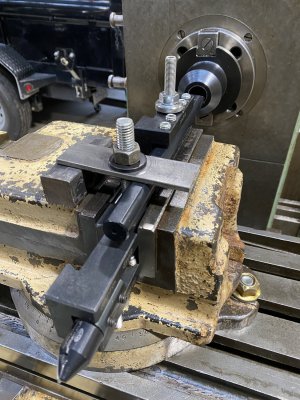The holder is definitely hard. I kept the RPM low (93RPM) and a slow feed rate of around 3/4" per minute. It's cutting, but I'm getting some taper to the bore (smaller as I go in) and I'm seeing the boring bar deflect rhythmically sideways through one section.
Yes, that's what turning hard steel slow with carbide does if the setup is not rigid enough. In your case the bar is the limiting factor most likely.
It sounds like prime candidate for cheap Chinese CBN inserts, but in their absence you do need a fairly sharp, coated carbide insert for it to work well with very light passes and slow cuts. The insert you had in the first picture looks like the one that worked well for me.
If slow cutting deflects even at low DOC (I don't think you mentioned the DOC other than it being light). If it is under 20 thou and it is still deflecting I would try another insert (as you did). If the insert is capable of taking such a small cut I would try 10 thou. If that deflected too I would sacrifice an insert for a fast cutting test. I suppose you absolutely need no taper in this holder as much as possible or the tool will wobble badly.
First a little disclaimer. This "fast hard cutting method" is discovered accidentally is definitely not the correct way to use carbide. Who knows, peroI have freak inserts that it works with, but will not with any others. So please be aware there is high chance of failure. Possibly even more so than with slow hard turning with ordinary steel carbide.
So for fast hard cutting with carbide you need a geometry that's opposite to slow cutting. A negative rake is OK, it doesn't need to be sharp much (but not chipped). Definitely needs at least yellow coating (as yours do). I probably would try the same insert first. For a roughly 1in bore you need at least 1000 rpm. I would start by taking a 1~2 thou cut, maybe increasing it to at most 10 thou if it worked well. The feed rate 2 thou per rev if possible.
I have a theory why it sometimes works. I believe the coating is doing all of the work and carbide beneath is just providing rigidity. You need crazy rigidity for it to work. That's why I used 1~2 thou cuts. Instead of being cut the hardened material rubs on the tip and heats up to yellow heat becoming soft, then it is just being pushed away just like with CBN. I don't know what kind of coating my inserts have (I have to check). I beleit is the "standard yellow one" you find on normal steel inserts so likely TiN. Just for comparison. Single crystal CBN has up to 5000hv hardness. The TiN coating gas half of it (2500~2600hv). Carbide typically used in inserts up to 1800hv. To bore that hole with cbn I would start with 1900rpm. I'm not sure if it works that way that half sfpm equals half as hard cutting material, but it is somewhat neat it just happened to work like this for me.
For sake of completeness I should mention there are also special carbide grades formulated for hard turning. I tried two Iscar ic908 and Mitsubishi vp15tf. I had no luck with both, but the material I was cutting was very hard cro-moly steel. Perhaps with low alloy carbon steel it would work fine? Who knows. In my use they chipped a lot sooner than my cheap steel insert. Also those "hard turning" inserts appear not to have any coatings.... So I can't understand how they are supposed to work. I did run them at prescribed feeds and speeds.
There are also ceramic inserts (sometimes called cermet) which many people have success with. They are very brittle, but for a continuous cut that should be fine. A youtube channel I watch (cutting edge engineering) uses them for hard turning with great success. He uses Ab30 grade from Ingersoll.
If everything fails (tapered bore etc) perhaps you can buy a single cbn (if your mill spins that fast) or that Ingersoll ceramic insert to avoid scraping the holder.
Coming back to ordinary steel carbide there is a lot of variability between simingly similar geometry inserts when hard turning. I had one last for 15min and another for 1 minute. The difference is just a chipbreaker(the good one had a simple one like on your first photo, the bad was a fancy one) . It might have been just a coincidence too.
I ran multiple passes through that area without changing the table position and it got better, but not completely....almost like it's a hard spot.
I'm going to have to confirm the insert is on center, see how much I can reduce the stick out and start trying slight variations. I almost think the DOC is a bit too shallow as the chips are very fine and mix with the cutting oil to make a slurry.
I'm pretty sure the end mill holder is a U.S. product, but the arbor is definitely German. A file did bite into the end mill holder, but not much. I'm worried the arbor is harder than the end mill holder!
Hopefully it is not very hard. If the file bites that may be anything from 35hrc to who knows how much (depending on the file, how hard you press etc).




